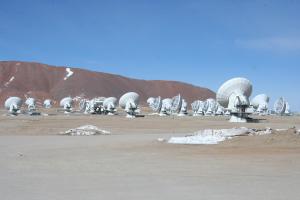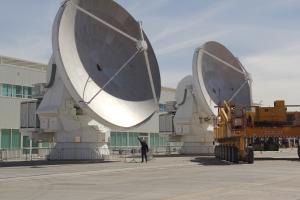Blog
Place of Departure
5 July 2015
 Mike Prokosch
Mike ProkoschChajnantor means “place of departure,” or more poetically “place of ascension” in the Kunza language of the Atacama region. It is a plateau about 5000 meters (16,000 feet) above sea level. Its elevation and arid climate makes for extremely difficult working conditions, but it also makes it perfect for the Atacama Large Millimeter/submillimeter Array, or ALMA.
ALMA is one of the first truly international astronomical endeavors. Rather than being spearheaded by a single nation with others lending primarily financial support, ALMA is a collaboration between the United States (NRAO), Europe (ESO), East Asia (NAOJ) and the Republic of Chile. It’s coordination has been likened to the United Nations. Given ALMA’s 1.4 billion dollar price tag, international collaboration was the only way the project was feasible.
 Tim Spuck
Tim SpuckALMA consists of more than 60 12-meter antennas as well as 12 7-meter antennas. The 7-meter antennas are designed to be closely spaced, forming the Atacama Compact Array (ACA). Since the antennas use interferometry to create images of the sky, the ACA creates a wide sky view, while the larger array of 12-meter antennas allows us to focus in on particular objects. The antennas can be moved to different locations to allow for different scales and resolutions.
The engineering of ALMA is incredibly ambitious. In order to combine signals from the antennas, a supercomputing correlator had to be built on the plateau. It is the highest altitude supercomputer on the planet. The correlator not only has to account for the arrangement of the antennas, but also the orientation of the Earth relative to the target object. As the Earth rotates, the effective separation of the antennas change. While this gradual change is a computing challenge, it also allows us to create a more complete image of objects.
Because ALMA focuses on millimeter wavelengths, it is perfectly suited to image cold molecular clouds, both in interstellar regions and surrounding young stars. Since it can image these clouds with the resolution similar to that of the Hubble telescope, it’s able to provide an incredible view of things like planets forming around other stars.
ALMA has only begun what is intended to be a 30-year mission to study the universe. As the largest international astronomy collaboration, it is perhaps fitting that it resides at Chajnantor, as it will likely be a place of departure toward some incredible astronomical discoveries.
This post was made possible in part by the ACEAP project, funded by the National Science Foundation.